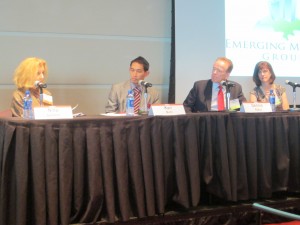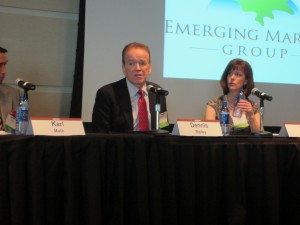Technology & New Innovations at Chicago Microfinance Conference
At Friday’s Chicago Booth and Zell Center Microfinance Conference, several of my colleagues and members of Young Ambassadors for Opportunity heard from Opportunity International‘s SVP of International Business Development, Dennis Ripley, who spoke as part of a panel called “New Products and Innovations in Microfinance,” along with Kate Cochran, COO at Vittana; Karl Muth, Consulting Economist at Grameen; and moderator Nina Diamond 0f DePaul University’s Richard H. Driehaus College of Business. (Jennifer Tescher, President and CEO of the Center for Financial Services Innovation, was scheduled to attend but her flight was delayed.) The panel discussed technology, trends in the microfinance industry, and the innovations being rolled out among the various organizations and entities.
 Kate Cochran explained that Vittana’s service is a peer-to-peer microlending website for students. It serves 3,000 students in 12 countries with interest- and risk-free loans at an average of $750, for a term of 12-36 months, and cosigned by an MFI with an appetite by innovation. Though this is higher than the traditional microfinance loan, Cochran says that, yes, these are microfinance loans and that the industry needs to expand its definition. She says that Vittana is a pilot intended to show the world that the microfinance model will work for students. Students are naturally very web-savvy, and their extensive familiarity with social media platforms “brings awareness and allows capital to flow.”
Kate Cochran explained that Vittana’s service is a peer-to-peer microlending website for students. It serves 3,000 students in 12 countries with interest- and risk-free loans at an average of $750, for a term of 12-36 months, and cosigned by an MFI with an appetite by innovation. Though this is higher than the traditional microfinance loan, Cochran says that, yes, these are microfinance loans and that the industry needs to expand its definition. She says that Vittana is a pilot intended to show the world that the microfinance model will work for students. Students are naturally very web-savvy, and their extensive familiarity with social media platforms “brings awareness and allows capital to flow.”
Karl Muth talked about reducing hard currency and other risks with expanded technology, though Grameen is not “driving technology, it’s consumer-driven.” He told a storyabout the changing nature of money transfer and the people’s finance transactions. On a recent trip to Uganda, he noticed the scarcity of buses. Just a few years ago, being a bus driver was a sought-after job in Uganda because drivers transported cash for people from urban to rural areas and received 5% as payment. But today, with so many cell phones that can transfer money and make remittances, the demand for cash-carriers has dried up and so in consequence, few people want to be bus drivers. Twelve hundred of Grameen’s clients in Uganda are using mobile money and making web-based transactions, said Muth, and Grameen has tech-savvy staff that travel around the country giving technology advice and training to clients. Muth sees Grameen as a an intermediary offering products that connect the client in the village to trillions of dollars in the global financial market. “The way we build products is important because efficient access is important,” he said.
Dennis Ripley talked about Opportunity’s microinsurance subsidiary MicroEnsure and the new insurance products made possible through cell phones and technology. Ripley explained that he and MicroEnsure CEO Richard Leftley had arranged a deal several years ago with TIGO in Ghana, one of the largest cell phone companies. For the cost of their regular $10 monthly cell phone fee, about 7,000 TIGO customers currently receive free access to term life insurance for themselves and one member of their family, with coverage at about 40 times that cost. Opportunity is also using social enterprise platform Salesforce to gather accurate household and land data for farmers (we’ve found that most incorrectly estimate the sizes of their land plots) in order to determine the appropriate size of their agricultural finance loans. Echoing one of the ongoing themes of the day, Ripley called savings the “holy grail of microfinance.” This is especially true for farmers, for whom savings improve cash flow until harvest time to help them pay their bills so that they don’t have to side-sell their crops at a deep undervaluation.
 In Malawi, Opportunity has created a financial distribution channel that ensures that clients are within 60-minute walking distance of a banking outlet. It employs the hub-and-spoke method with satellite branches, ATMs, biometric smart cards, mobile banking vehicles, teller-staffed kiosks, and point-of-sale (POS) devices. Just as they were finished building this matrix, and Opportunity Malawi was about to reach 90% coverage, M-PESA exploded in Kenya and so Ripley and the Opportunity Malawi leadership decided to map out the country’s cell towers as well, and now Malawian clients can use their cell phones to make financial transactions too–we estimate that every Opportunity Malawi client lives or works within no more than one kilometer of a banking outlet. Today, Opportunity Malawi serves over 421,000 deposit clients and over 57,000 loan clients. Once we start taking deposits, Ripley explains, we are able to think more creatively and strategically about our value chains. In Southern Nicaragua, for instance, we’re offering tools that combine the rapidly growing fields of agriculture and tourism to help move the needle on poverty. In Granada, we’ve opened the innovative Emprendadora School, which offers a traditional high school education plus hands-on experience in those fields.
In Malawi, Opportunity has created a financial distribution channel that ensures that clients are within 60-minute walking distance of a banking outlet. It employs the hub-and-spoke method with satellite branches, ATMs, biometric smart cards, mobile banking vehicles, teller-staffed kiosks, and point-of-sale (POS) devices. Just as they were finished building this matrix, and Opportunity Malawi was about to reach 90% coverage, M-PESA exploded in Kenya and so Ripley and the Opportunity Malawi leadership decided to map out the country’s cell towers as well, and now Malawian clients can use their cell phones to make financial transactions too–we estimate that every Opportunity Malawi client lives or works within no more than one kilometer of a banking outlet. Today, Opportunity Malawi serves over 421,000 deposit clients and over 57,000 loan clients. Once we start taking deposits, Ripley explains, we are able to think more creatively and strategically about our value chains. In Southern Nicaragua, for instance, we’re offering tools that combine the rapidly growing fields of agriculture and tourism to help move the needle on poverty. In Granada, we’ve opened the innovative Emprendadora School, which offers a traditional high school education plus hands-on experience in those fields.
In addition to the products Ripley detailed here, Opportunity’s partnership with Credit Suisse helps us implement further innovations, including Euronet in Malawi, a system that produces bank cards at a lower overall cost for clients and banks, and the rollout of the T24 Emerge Technology System in Colombia, enabling us to grow our bank and expand our offerings of services and financial products to our clients. In Ghana, Credit Suisse supports the marketing and expansion of branchless banking through cell phones, ATMs and POS devices.
For me, the takeaway from this panel was the efficacy of microfinance’s new innovations and existing technology, as well as the ongoing need for even more efficient tools that meet clients’ needs. Clients are innovative and resourceful, and they will find ways to access existing technology like cell phones in order to spend less of their day accessing financial services and more time growing their businesses and improving the economic situation of themselves and their families. Microfinance organizations can give their clients the best shot at improving their situations by continuing to innovate with the most effective technological tools.